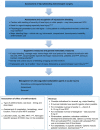Antithrombotics in trauma: management strategies in the older patients
- PMID: 29042825
- PMCID: PMC5633276
- DOI: 10.2147/JBM.S125209
Antithrombotics in trauma: management strategies in the older patients
Abstract
The ageing population has resulted in a change in the demographics of trauma, and older adult trauma now accounts for a growing number of trauma admissions. The management of older adult trauma can be particularly challenging, and exhibits differences to that of the younger age groups affected by trauma. Frailty syndromes are closely related with falls, which are the leading cause of major trauma in older adults. Comorbid disease and antithrombotic use are more common in the older population. Physiological changes that occur with ageing can alter the expected clinical presentation of older persons after injury and their susceptibility to injury. Following major trauma, definitive control of hemorrhage remains essential for improving outcomes. In the initial assessment of an injured patient, it is important to consider whether the patient is taking anticoagulants or antiplatelets and if measures to promote hemostasis such as reversal are indicated. After hemostasis is achieved and bleeding has stopped, longer-term decisions to recommence antithrombotic agents can be challenging, especially in older people. In this review, we discuss one aspect of management for the older trauma patients in greater detail, that is, acute and longer-term management of antithrombotic therapy. As we consider the health needs of an ageing population, rise in elderly trauma and increasing use of antithrombotic therapy, the need for research in this area becomes more pressing to establish best practice and evidence-based care.
Keywords: anticoagulation; antiplatelet; antithrombotic; elderly; injury.
Conflict of interest statement
Disclosure The authors report no conflicts of interest in this work.
Figures


Similar articles
-
Antithrombotic Agent Use in Elderly Patients Sustaining Low-Level Falls.J Surg Res. 2021 Feb;258:216-223. doi: 10.1016/j.jss.2020.08.047. Epub 2020 Oct 5. J Surg Res. 2021. PMID: 33032140
-
Residential medication management reviews of antithrombotic therapy in aged care residents with atrial fibrillation: assessment of stroke and bleeding risk.J Clin Pharm Ther. 2016 Jun;41(3):279-84. doi: 10.1111/jcpt.12385. Epub 2016 Apr 7. J Clin Pharm Ther. 2016. PMID: 27062272
-
Assessment of bleeding risk of interventional techniques: a best evidence synthesis of practice patterns and perioperative management of anticoagulant and antithrombotic therapy.Pain Physician. 2013 Apr;16(2 Suppl):SE261-318. Pain Physician. 2013. PMID: 23615893 Review.
-
The role of delayed head CT in evaluation of elderly blunt head trauma victims taking antithrombotic therapy.Eur J Trauma Emerg Surg. 2017 Dec;43(6):741-746. doi: 10.1007/s00068-017-0793-7. Epub 2017 Apr 24. Eur J Trauma Emerg Surg. 2017. PMID: 28439613
-
Safety of Antithrombotic Agents in Elderly Patients with Acute Coronary Syndromes.Drugs Aging. 2016 Apr;33(4):233-48. doi: 10.1007/s40266-016-0359-0. Drugs Aging. 2016. PMID: 26941087 Review.
Cited by
-
Antithrombin III Levels and Outcomes Among Patients With Trauma.JAMA Netw Open. 2024 Aug 1;7(8):e2427786. doi: 10.1001/jamanetworkopen.2024.27786. JAMA Netw Open. 2024. PMID: 39145978 Free PMC article.
-
Leveraging Dual Usability Methods to Evaluate Clinical Decision Support Among Patients With Traumatic Brain Injury: Mixed Methods Study.JMIR Hum Factors. 2025 Jul 30;12:e60268. doi: 10.2196/60268. JMIR Hum Factors. 2025. PMID: 40737617 Free PMC article.
-
Diagnostic and therapeutic approach in adult patients with traumatic brain injury receiving oral anticoagulant therapy: an Austrian interdisciplinary consensus statement.Crit Care. 2019 Feb 22;23(1):62. doi: 10.1186/s13054-019-2352-6. Crit Care. 2019. PMID: 30795779 Free PMC article.
-
Hemorrhage of the Ramus Lumbalis of the Iliolumbar Artery as a Cause for Shock in Blunt Trauma Victims on Therapeutic Anticoagulation.Case Rep Surg. 2021 Jan 15;2021:8870154. doi: 10.1155/2021/8870154. eCollection 2021. Case Rep Surg. 2021. PMID: 33510926 Free PMC article.
-
Pseudoaneurysm of the Anterior Interosseous Artery and Anterior Interosseous Nerve Palsy. A Rare Postoperative Complication of Ulnar Fracture Osteosynthesis: A Case Report.Maedica (Bucur). 2021 Sep;16(3):522-525. doi: 10.26574/maedica.2020.16.3.522. Maedica (Bucur). 2021. PMID: 34925612 Free PMC article.
References
-
- National Institute for Health and Care Excellence . Major trauma: assessment and initial management. 2016. (NICE Guideline [NG39]). - PubMed
-
- TARN TARN 2017 report: major trauma in older people. 2017. [Accessed September 7, 2017]. Available from: https://www.ons.gov.uk/peoplepopulationandcommunity/populationandmigrati....
-
- Cooper Z, Maxwell CA, Fakhry SM, et al. A position paper: the convergence of aging and injury and the need for a Geriatric Trauma Coalition (GeriTraC) J Trauma Acute Care Surg. 2017;82(2):419–422. - PubMed
Publication types
LinkOut - more resources
Full Text Sources
Other Literature Sources
Research Materials

